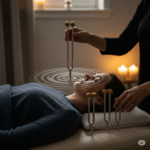Top Selling Oil Diffuser Reviewed: Best Models for 2025 Insights

Oil diffusers have become essential for creating a calm and inviting atmosphere in homes and offices. They disperse essential oils into the air, offering benefits such as improved mood, relaxation, and even better sleep. The top selling oil diffusers combine effective misting technology, quiet operation, and sleek design to meet these needs efficiently.
Customers often prioritize diffusers that are easy to use, durable, and versatile in mist settings. Popular models also include features like timer controls and built-in LED lights, enhancing their appeal. These factors contribute to why certain oil diffusers consistently top sales charts.
Understanding what makes a diffuser best-selling helps buyers make informed decisions. This article explores leading products that deliver quality and functionality, helping users find the ideal option for their space.
What Is an Oil Diffuser?
An oil diffuser disperses essential oils into the air, allowing the aroma to fill a room. It creates a scent environment that can affect mood, air quality, and relaxation.
The technology varies, impacting how the oil is released and how long the scent lasts.
How Oil Diffusers Work
Oil diffusers break essential oils into small particles to disperse them in the air. Some use ultrasonic vibrations to create a fine mist, combining water and oil. This method also adds humidity to the room.
Others use heat to evaporate the oils, releasing them as vapor. This can slightly change the oil’s chemical composition due to the heat applied.
Nebulizing diffusers force air through the oil directly, producing a concentrated aerosol without heat or water. This retains the oil’s integrity but consumes more oil faster.
Types of Oil Diffusers
Ultrasonic diffusers use water and vibrations to create a cool mist. They double as humidifiers and are quiet.
Heat diffusers use a small warming element to release scent. They are simple but may alter some oil properties.
Nebulizing diffusers disperse pure oil using air pressure, offering the strongest fragrance with no dilution.
Evaporative diffusers use a fan to blow air through a pad with oil, quickly dispersing scent but often less intense.
Benefits of Using Top Selling Oil Diffusers
Top selling oil diffusers offer multiple practical benefits related to health, indoor air quality, and aromatherapy. They combine technology and natural essential oils to create a healthier and more pleasant environment.
Health and Wellness Advantages
Oil diffusers help deliver essential oils that may support relaxation and reduce stress. Certain oils like lavender and eucalyptus have properties linked to calming effects and aiding sleep.
Regular use can contribute to respiratory comfort by loosening mucus and soothing airways. Diffusers using ultrasonic technology produce fine mist that does not irritate the throat.
They also provide a chemical-free alternative to air fresheners, reducing exposure to synthetic fragrances and potential allergens.
Air Quality Improvement
Top models often include features that humidify indoor air, which can prevent dryness that causes irritation in the skin and respiratory tract. This is especially valuable in dry climates or during winter.
Diffusing oils like tea tree or peppermint may have mild antibacterial effects, helping reduce airborne pathogens. While not a replacement for cleaning, this can enhance indoor air freshness.
The gentle mist emitted also helps maintain balanced humidity levels between 40-60%, a range favored by health experts for comfort and hygiene.
Aromatherapy Uses
Oil diffusers maximize the therapeutic potential of essential oils by dispersing them evenly throughout a room. This method is more effective than burning or direct inhalation.
They enable users to customize scent combinations tailored to different needs such as focus, relaxation, or mood enhancement. Popular oils for focus include rosemary and peppermint.
Many units offer adjustable settings to control diffusion intensity and duration, providing flexibility for various environments and preferences. This versatility makes them suitable for home, office, or spa use.
Features of Top Selling Oil Diffusers
Top selling oil diffusers combine practical design with functional capacity and user-friendly controls. These factors directly affect performance, ease of use, and maintenance, which are critical for customer satisfaction.
Design and Materials
Top oil diffusers typically feature sleek, modern designs that blend well with various interior styles. Many use BPA-free plastic or natural wood finishes for durability and aesthetic appeal.
The materials are chosen not only for looks but also for resistance to water and essential oils, preventing corrosion or discoloration. Compact shapes with simple, intuitive interfaces are common, making them easy to place anywhere in the home or office.
Many models include LED indicators or ambient lighting options that enhance appearance without complicating use. The texture and build quality also ensure a stable base, minimizing the risk of spills.
Capacity and Coverage
Capacity ranges from about 100 ml to 500 ml, depending on the model, influencing the runtime and the size of the room it can serve. Smaller diffusers cover areas up to 200 square feet, while larger units handle spaces close to 500 square feet or more.
Most top sellers run continuously for 6 to 12 hours, with some offering intermittent mist modes to extend operation. A larger water tank means fewer refills and better performance in bigger rooms.
Coverage efficiency depends on mist output rate, usually measured in ml per hour. Popular models balance output and water consumption to maintain consistent diffusion without quick depletion.
Control and Timer Options
Control settings are crucial for convenience and energy management. Leading diffusers offer multiple timer modes such as 1, 3, or 6 hours, plus continuous operation.
Many units provide automatic shut-off features when water runs low, enhancing safety and protecting the device from damage. Some include remote controls or smartphone app integration for added flexibility.
User interfaces vary from simple push buttons to touch-sensitive controls with clear indicators. Adjustable mist intensity settings let the user customize the aromatic experience according to room size or personal preference.
How to Choose the Top Oil Diffuser
Selecting the right oil diffuser involves evaluating several practical factors and aligning features with personal preferences and space requirements. Attention to details like capacity, operation mode, and design ensures it fits well into the intended environment.
Key Factors to Consider
Capacity is crucial; larger tanks run longer without refilling, suitable for bigger rooms. For small spaces, compact models with smaller reservoirs suffice and save space.
Ultrasonic diffusers are popular for quiet operation and added air humidifying benefits. Others use heat or nebulizing methods, which vary in intensity and scent dispersion.
Timer settings and automatic shut-off are important safety features. Users should check if the diffuser has adjustable mist levels to control scent strength.
Material quality impacts durability. Many use BPA-free plastic or glass, which resist wear and do not interfere with essential oils.
Matching Features to Needs
For bedrooms or offices, quiet operation and timer settings are vital to avoid disruptions. Users seeking therapeutic benefits might prioritize nebulizing diffusers for stronger aromas.
Those who want ambiance may look for diffusers with LED lighting and customizable colors. Some prefer models compatible with smart home systems for remote control.
Portability matters for travelers or small apartments; battery-operated or USB-powered designs offer convenience.
Ultimately, matching diffuser size, mist capacity, and additional functions to the user’s daily routine improves satisfaction with the product.
